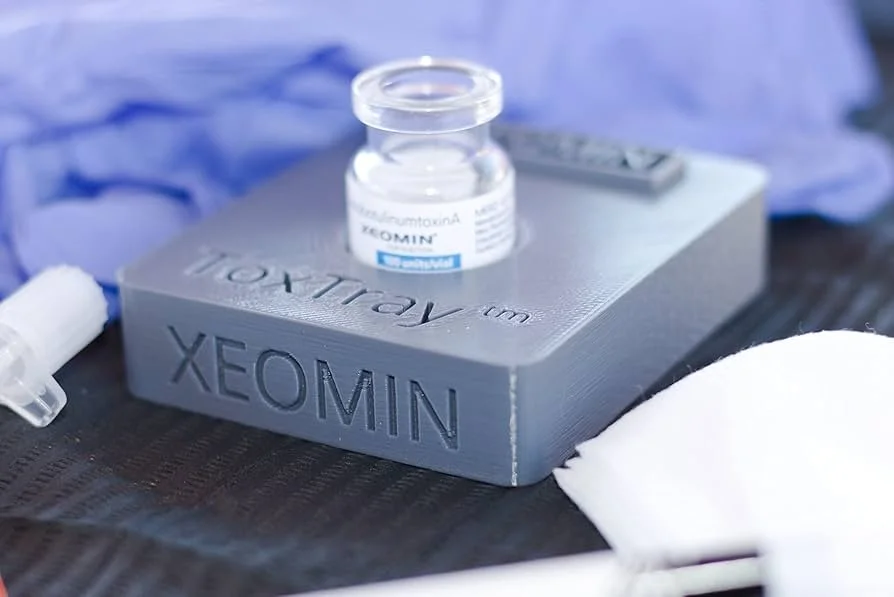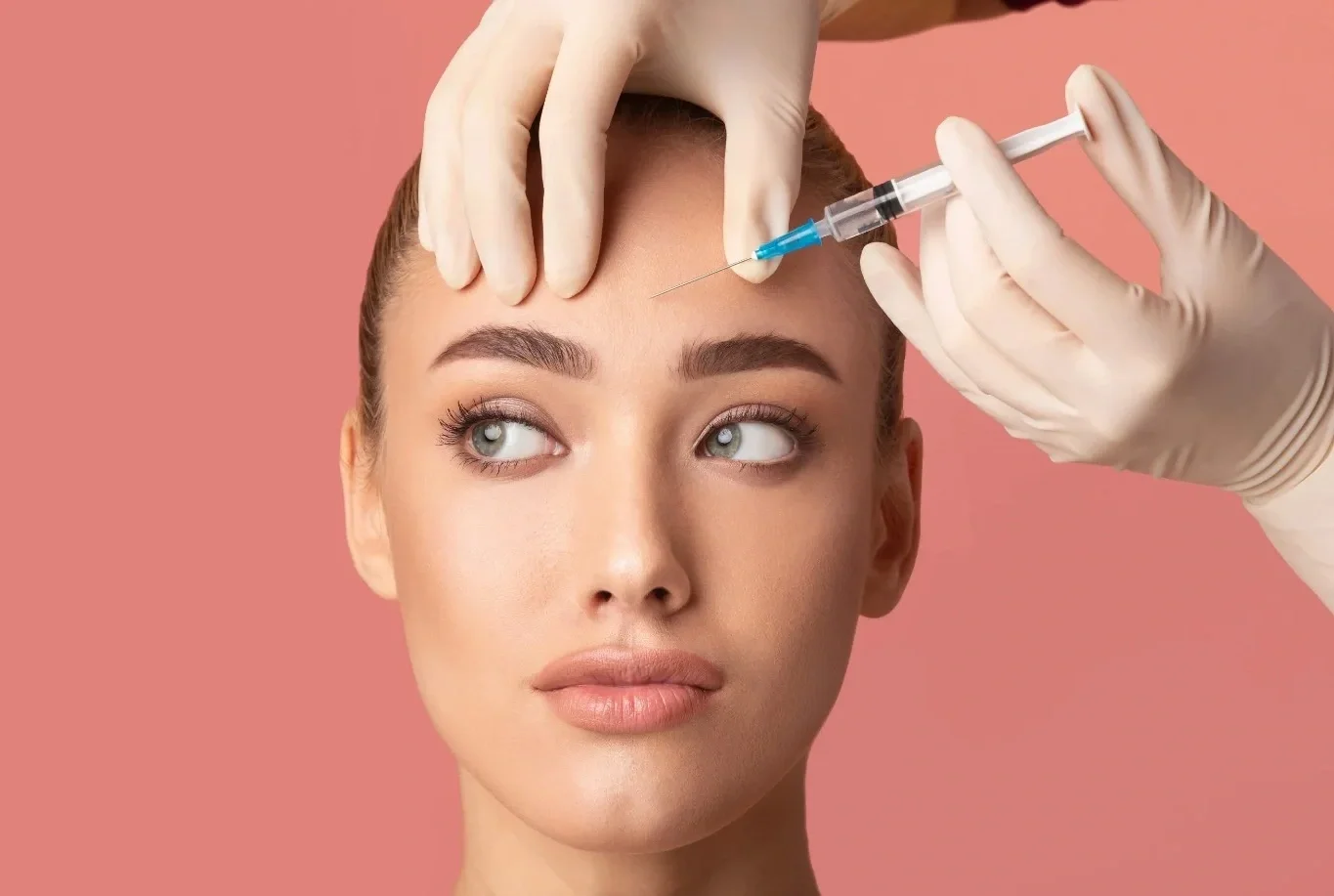
Neurotoxins
What are Neurotoxins?
In medical aesthetics, neurotoxins like Botox, Dysport, and Xeomin are used to reduce dynamic wrinkles by temporarily blocking acetylcholine, a neurotransmitter that causes muscle contractions. These injections work by relaxing targeted facial muscles to prevent the formation of lines and wrinkles from expressions like frowning or squinting. Common applications include smoothing forehead lines, crow's feet, and frown lines between the eyebrows, but they are also used for jaw slimming, lip flips, neck bands, and treating excessive sweating or teeth grinding.
Treatment Areas
How do they work?
Neurotransmitter Blocking: Neurotoxins block the release of acetylcholine, the chemical messenger that tells muscles to contract.
Muscle Relaxation: By inhibiting acetylcholine, the treated muscles are temporarily relaxed.
Reduced Wrinkles: With relaxed muscles, the overlying skin becomes smoother, and lines from facial expressions are softened or eliminated.

Benefits of Tox Injections
Wrinkle Reducation
Neurotoxins are a highly effective treatment for dynamic wrinkles, which are caused by repetitive muscle movements, by temporarily relaxing the underlying muscles. While neurotoxins primarily target dynamic lines, they can also indirectly improve static wrinkles (lines visible at rest) by preventing them from deepening over time and allowing the skin to smooth out.
Targeted Treatments
Neurotoxin aesthetic treatments target and temporarily relax specific muscles responsible for dynamic wrinkles by blocking nerve signals, leading to smoother, more youthful skin. Popular treatments like Botox, Dysport,and Xeomin are used to address forehead lines, crow's feet, and frown lines, but also offer targeted benefits like jawline slimming, neck band reduction, and correction of a gummy smile.
Versatile Benefits
Neurotoxins offer versatile benefits in aesthetics by temporarily relaxing muscles to reduce dynamic wrinkles, enhance features like the lips and nose, and even address medical conditions like excessive sweating and migraines. Their benefits range from wrinkle reduction and smile improvement to managing TMJ pain and muscle spasms, providing a non-invasive and customizable option for both cosmetic rejuvenation and therapeutic relief.
Customized Approach
Neurotoxin injections can be customized to achieve personalized and natural-looking results. A skilled injector will evaluate your unique facial anatomy, muscle activity, and aesthetic goals to create a tailored treatment plan. The customizable aspects involve the choice of neurotoxin, the dosage, the injection sites, and the overall treatment philosophy.
Increased Self-Esteem
Studies have shown that individuals who receive these treatments report higher levels of self-confidence and improved psychological well-being, which can positively impact social interactions and overall life quality. Beyond the physical benefits, research suggests a connection between the reduction in dynamic facial lines and improvements in mood and a decrease in depression and anxiety related to self-image.
Medicinal Uses
Neurotoxins offer benefits in both aesthetics and medicine by temporarily blocking nerve signals to muscles, leading to wrinkle reduction, muscle spasm relief, and treatment for conditions like migraines and hyperhidrosis. In aesthetics, they smooth facial lines and can be used preventatively. Medically, they are used for chronic migraines, muscle stiffness, and excessive sweating (hyperhidrosis), and TMJ dysfunction.
Quick Onset & Long Lasting Resuls
The effects of neurotoxin injections kick in as soon as day 2-3 though results are not permanent; muscle action will gradually return. This happens because the body metabolizes the neurotoxin over time, and the nerve endings start to reconnect with the muscles. Results typically last four to six months. Longevity of results is influenced by multiple factors: brand of neurotoxin, patient metabolism, and dosage.
Preventative Care
For aesthetics, neurotoxins are used as a form of preventative care to inhibit muscle movements that cause wrinkles over time, which delays the formation of deep lines. This proactive approach offers several benefits, including more subtle and natural-looking results, reduced need for more invasive procedures later on, and potential cost savings over the long term.
Neurotoxins
-

Botox (onabotulinumtoxinA)
-

Dysport (abobotulinumtoxinA)
-

Xeomin (incobotulinumtoxinA)
Similarities
Xeomin, Botox, and Dysport use botulinum toxin type A to relax muscles and reduce wrinkles
All FDA-approved for cosmetic use, primarily to treat frown lines
Used for both medical conditions and cosmetic procedures
Differences
Xeomin is a "naked" injectable with only the active botulinum toxin, while other injectables include accessory proteins
Some find that Xeomin is less likely to cause a reaction or resistance due to its lack of accessory proteins
Xeomin is considered to spread the least under the skin compared to Botox and Dysport
FAQs
FAQs
-
Brow Lift
Bunny Lines (Medial Canthal Lines)
Chin Dimpling
Crow’s Feet (Lateral Canthal Lines)
Forehead Lines
Frowning / Marionettes (DAO)
Glabellar Lines (11’s)
Gummy Smile
Hyperhydrosis (excessive sweating)
Jelly Roll Deformity (Lower Eyelid)
Lip Flip
Masseter Muscles (Facial Slimming/TMJ Dysfunction)
Platysma (Neck) Bands (Neck Lines)
Trap Tox (Barbie Tox)
-
Xeomin is a pure injectable that contains only botulinum neurotoxin type A. Dysport has extra proteins called neurotoxin-associated proteins, which can change the diffusion and potency of the treatment. Because of this, it’s important to choose an experienced provider for Dysport to minimize this risk and achieve your desired look.
-
There’s no one-size-fits-all answer. The number of units needed varies depending on the area being treated, your unique facial anatomy, and the results you’re hoping to achieve. The best way to determine what’s right for you is through a personalized consultation. During your visit, we’ll assess your goals and create a customized treatment plan to help you achieve your desired look.
-
There are two ways to structure your pricing as it relates to neurotoxin dosage. There is the ‘area’ based scale versus the ‘unit’ based scale. As a patient, personally; I value transparency and so it goes to follow I want to know what I recieved (dysport, xeomin, botox) and how much I recieved. It’s the most valuable tool for the client to then determine if that is their standard maintenance dose or if they prefer to scale up or down based on that.
-
No, though it may be helpful to know that Dysport: Botox: Xeomin is 3:1:1. Meaning one unit of Xeomin or Botox is 3 units of Dysport. For simplistic purposes I always account for the conversion so that nobody is pulling out their Texas Instrument calculator.



